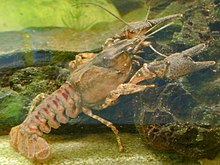
Crayfish are freshwater crustaceans resembling small lobsters. In some locations, they are also known as crawfish, craydids, crawdaddies, crawdads, freshwater lobsters, mountain lobsters, rock lobsters, mudbugs, or yabbies. Taxonomically, they are members of the superfamilies Astacoidea and Parastacoidea. They breathe through feather-like gills. Some species are found in brooks and streams, where fresh water is running, while others thrive in swamps, ditches, and paddy fields. Most crayfish cannot tolerate polluted water, although some species, such as Procambarus clarkii, are hardier. Crayfish feed on animals and plants, either living or decomposing, and detritus.

The signal crayfish is a North American species of crayfish. It was introduced to Europe in the 1960s to supplement the North European Astacus astacus fisheries, which were being damaged by crayfish plague, but the imports turned out to be a carrier of that disease. The signal crayfish is now considered an invasive species across Europe, Japan, and California ousting native species there.

Astacidea is an infraorder of decapod crustaceans including lobsters, crayfish, and their close relatives.

The Cambaridae are the largest of the three families of freshwater crayfish, with over 400 species. Most of the species in the family are native the United States east of the Great Divide and Mexico, but fewer range north to Canada, and south to Guatemala and Honduras. Three live on the island of Cuba. The species in the genus Cambaroides are the only found outside North America, as they are restricted to eastern Asia.

Procambarus clarkii, known variously as the red swamp crayfish, Louisiana crawfish or mudbug, is a species of cambarid crayfish native to freshwater bodies of northern Mexico, and southern and southeastern United States, but also introduced elsewhere, where it is often an invasive pest.

The rusty crayfish is a large, aggressive species of freshwater crayfish which is native to the United States, in the Ohio River Basin in parts of Ohio, Kentucky, and Indiana. Its range is rapidly expanding across much of eastern North America, displacing native crayfishes in the process. The rusty crayfish was first captured in Illinois in 1973, and has been collected at over 20 locations in the northern portion of the state. In 2005, F. rusticus was found for the first time west of the Continental Divide, in the John Day River, Oregon, which runs into the Columbia River.

Austropotamobius torrentium, also called the stone crayfish, is a European species of freshwater crayfish in the family Astacidae. It is mostly found in tributaries of the Danube, having originated in the northern part of the Balkan Peninsula.

Faxonius sloanii is a species of decapods in the family Cambaridae, endemic to Indiana and Ohio. It is associated with freshwater habitats. Although it is being slowly out-competed by the rusty crayfish, it is listed as a species of Least Concern on the IUCN Red List.

The marbled crayfish or Marmorkrebs is a parthenogenetic crayfish that was discovered in the pet trade in Germany in 1995. Marbled crayfish are closely related to the "slough crayfish", Procambarus fallax, which is widely distributed across Florida. No natural populations of marbled crayfish are known. Information provided by one of the original pet traders as to where the marbled crayfish originated was deemed "totally confusing and unreliable". The informal name Marmorkrebs is German for "marbled crayfish".

Faxonius virilis is a species of crayfish known as the virile crayfish, northern crayfish,eastern crayfish, and lesser known as the lake crayfish or common crawfish. Faxonius virilis was reclassified in August 2017, and the genus was changed from Orconectes to Faxonius. It is native to eastern United States and southeast Canada.

Faxonius immunis is a species of crayfish in the family Cambaridae. It is native to North America and it is an introduced species in Europe, where it lives along the Upper Rhine. Its common names include calico crayfish and papershell crayfish.

Dikerogammarus villosus, also known as the killer shrimp, is a species of amphipod crustacean native to the Ponto-Caspian region of eastern Europe, but which has become invasive across the western part of the continent. In the areas it has invaded, it lives in a wide range of habitats and will prey on many other animals. It is fast-growing, reaching sexual maturity in 4–8 weeks. As it has moved through Europe, it threatens other species and has already displaced both native amphipods and previous invaders.
Faxonius alabamensis, the Alabama crayfish, is a species of freshwater crayfish that lives in Alabama, Mississippi and Tennessee.
Faxonius maletae, sometimes called the Kisatchie painted crayfish or Kisatchie painted crawfish, is a species of crawdad in the Cambaridae family. The specific epithet maletae is in honor of the discoverer's wife, author Maleta M. Walls, who helped collect many of the original specimens. It was originally described as a subspecies of Orconectes difficilis, but later elevated to full species status. The common name refers to the Kisatchie National Forest, near where the original specimens were found in Bayou Santabarb.

Procambarus acutus, the white river crayfish, is a species of crayfish in the family Cambaridae. It is found in North America and Europe.

Faxonius validus, the powerful crayfish, is a species of crayfish in the family Cambaridae. It is found in North America.

Faxonius is a genus of malacostracans in the family Cambaridae. There are more than 90 described species in Faxonius. It includes the rusty crayfish, an invasive species in North America, and three species, F. virilis, F. immunis, and F. limosus, that are invasive to Europe.















